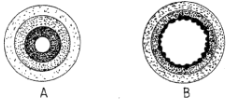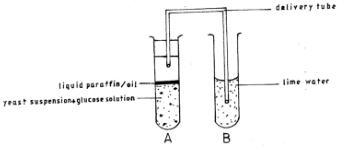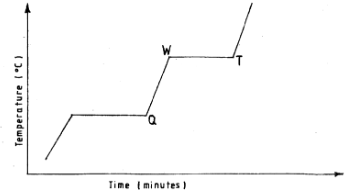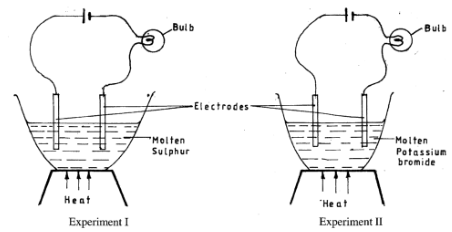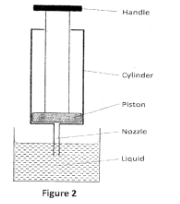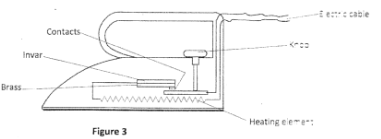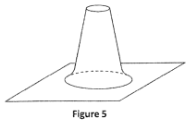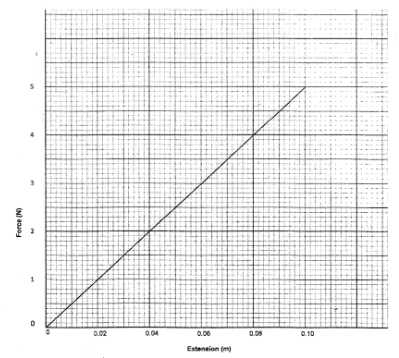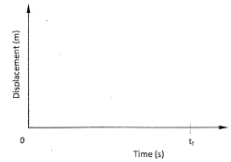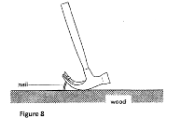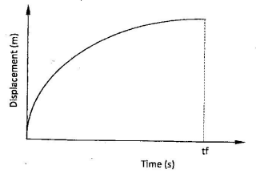SECTION A: BIOLOGY (34 marks)
Answer all the questions in this section in the spaces provided.
-
- Give two reasons why a child requires more energy than an adult. (2 marks)
- How can the presence of lipids in a food substance be confirmed without using chemical reagents?
(2 marks)
-
- State one example of an organism in the kingdom protoctista. (1 mark)
- Classify maize (zea mays) into its first two largest taxonomic units. (2 marks)
- The diagrams below illustrate a set-up that form one students used to demonstrate a certain physiological process and the result after two hours.
- Name the physiological process that was being demonstrated. (1 mark)
- Explain the observation made after two hours. (3 marks)
- The diagrams below represent cross sections of human blood vessels.
-
- Name the blood vessel labelled A. (1 mark)
- Give a reason for your answer in (a) (i) above.
(1 mark)
- How is the blood vessel labelled B adapted to its function? (2 marks)
-
-
- Differentiate between excretion and egestion. (2 marks)
- How does the liver help to maintain a constant body temperature in human beings? (2 marks)
- State two causes of kidney stones. (2 marks)
- The diagram below shows an experimental set-up to demonstrate a biological process.
- Name the process being demonstrated. (1 mark)
- State the observations made during the demonstration, (2 marks).
- Form one students set up an experiment to demonstrate a physiological process as shown in the diagrams below.
- Why were bubbles not produced in the set-up labelled D? (2 marks)
- Name the gas collected in the set-up labelled C. (1 mark)
- Complete and label the drawing below to make it appear like that of a typical plant cell as seen under a light microscope. (3 marks)
- State four factors that affect the rate of breathing in human beings. (4 marks)
SECTION B: CHEMISTRY (33 marks)
Answer all the questions in this section in the spaces provided.
- The diagram below shows changes in states of matter under different conditions. Study it and answer the question that follows.
Give the names of the changes represented by the letters J and K. (1 mark) -
- Complete the following word equation. (1 mark)
Dilute sulphuric (VT) acid + Solid sodium carbonate - Give one commercial use of sulphuric (VT) acid. (1 mark)
- Complete the following word equation. (1 mark)
- Three experiments were set up as shown below to investigate the conditions necessary for rusting to occur.
- After three days, only the nails in experiment III had rusted. Why didn't rusting occur in experiments I and II ? ( 2marks)
- What would be the effect of using salty water instead of tap water in experiment III? (1 mark)
- Complete the table below by stating the type of oxides formed when the following substances are burnt in air. (1 mark)
Substance Type of oxide Hydrogen Neutral Phosphorus Magnesium
- The diagram below shows a reduction - oxidation process. Study it and answer the questions that follow.
- Write an equation for the reaction between dry hydrogen gas and hot copper II oxide. (1 mark)
- In the process above, which substance undergoes oxidation? Explain (1 mark)
- Name the substance that burns at X? (1 mark)
-
- The two main isotopes of carbon are
and
with relative abundances of 98.8% and 1.2% respectively. Calculate the relative atomic mass (RAM) of carbon. (2 marks)
- The elements X and Y have atomic numbers 13 and 17 respectively. Write the electronic configuration of:
- ion of X (½ mark)
- Y (½ mark)
- Write the formula of the compound formed when X reacts with Y. (1 mark)
- The two main isotopes of carbon are
- The table below represents part of the periodic table. The letters do not represent the actual symbols of the elements. Use it to answer the questions that follow.
- Which element would be most reactive with water? Explain. (2 marks)
- Explain why element is non-reactive. (1 mark)
- Identify the element which is in the group of alkaline earth metals. (½ mark)
- Element and R would react to form a compound PR. What type of bond exists in compound PR? (½ mark)
-
- Water hardness is classified as either temporary or permanent. What are the causes of permanent hardness in water? (2 marks)
- How is temporary water hardness commonly removed? (1 mark)
- Given 50 cm3 of dilute hydrochloric acid in a beaker, describe how solid calcium chloride could be prepared using calcium carbonate. (3 marks)
- The graph below shows variation of temperature when ice is heated over a period of time.
- Using kinetic theory, explain the changes between points:
- Q and W (1½ marks)
- W and T (1½ marks)
- Name the apparatus that can be used to separate a mixture of water and oil. (1 mark)
- Using kinetic theory, explain the changes between points:
-
- Using dot (.) and cross (X) diagram, illustrate the type of bonding in carbon (IV) oxide (Atomic numbers: C = 6;O=8). (2 marks)
- Give a reason why graphite conducts electricity (1 mark)
- The diagrams below show set-up of experiments done to investigate conduction of electric current by some substances. Study the diagrams and answer the question that follows.
In which experiment does the bulb light? Explain. (2 marks)
SECTION C: PHYSICS (33 marks)
Answer all the questions in this section in the spaces provided.
- Figure 1(a) shows a stone of mass 144 g immersed in water. Before the stone was immersed. the level of water was as shown in figure 1(b). Determine the density of the stone. (3 marks)
- The weight of an object is 23.5 N. Determine the mass of the object given that the acceleration due to gravity is 10 ms−2 (3 marks)
-
- State the reason why atmospheric pressure at sea level is greater than at a higher altitude (1 mark)
- Figure 2 shows a syringe with its nozzle dipped in a liquid.
It is observed that when the piston is pulled upwards the liquid enters the cylinder. Explain this observation (2 marks)
- State the reason why the volume of a gas is always equal to the volume of the vessel containing (1 mark)
-
- Define the term temperature. (1 mark)
- Figure 3 shows an electric iron box in which a brass-invar bimetallic strip is used to control the temperature.
Given that brass expands more than invar, describe how the bimetallic strip controls the temperature of the iron box. (2 marks)
- When one end of a metal is heated, the other end gets hot. Explain this observation. (2 marks)
- Figure 4 shows a uniform rod 120 cm long and weighing 15 N. The rod is pivoted at 20 cm from one end and is balanced by two forces, 10 N and F.
Determine the magnitude of E. (3 marks) - Figure 5 shows a drinking glass placed upside down on a table.
- Name its state of equilibrium. (1 mark)
- State a reason for your answer in (a). (1 mark)
- Figure 6 shows a graph of force against extension for a spring.
Use the graph to determine the spring constant. (3 marks) - A stone is thrown vertically upwards. On the axes provided sketch the displacement-time graph for the motion of the stone from the time it is thrown to the time, when it reaches the maximum height.
(2 marks) - Figure 7 shows a wheelbarrow being used to carry a box in the direction shown.
When the wheelbarrow is suddenly stopped the box slides forward. Explain why the box slides forward.
(2 marks) -
- Figure 8 shows a hammer being used as a machine to remove a nail from a piece of wood.
Indicate with an arrow on the hammer, the position where the least effort should be applied to remove the nail. (1 mark) - Light from the sun is used by a solar panel to charge a car battery. State the energy changes that take place from the sun to the solar panel and finally to the battery. (2 marks)
- Figure 8 shows a hammer being used as a machine to remove a nail from a piece of wood.
- Figure 9 shows a metal block suspended from a spring balance and partially immersed in
- State what will be observed in the reading of the balance if the block is lowered further into the water (1 mark)
- Explain your answer in (a). (2 marks)

MARKING SCHEME
SECTION A: BIOLOGY (34 marks)
-
- The child requires more energy than an adult for rapid cell division/ growth; and high activity/high metabolic rate; (2 marks)
- A translucent mark; when the food substance is rubbed on a piece of paper confirms presence of lipids; (2 marks)
-
- Amoeba/plasmodium/ paramecium/ spyrogyra; (1 mark)
- Kingdom: plantae; (1 mark)
Division: spermatophyta: (1 mark)
-
- Osmosis; (1 mark)
- Visking tube bulged because sugar solution is hypertonic; and distilled water is hypotonic; therefore water molecules moved into the visking tube by osmosis; (3 marks)
-
-
- Artery:
- Thick walled small lumen; (2 marks)
- Have valves; to prevent backflow of blood;
Has large lumen/is lined with smooth muscles; to facilitate smooth flow of blood;
Any one correct (2 marks)
-
-
- Excretion is the elimination of metabolic waste products: Egestion is the elimination of undigested and indigestible materials from the alimentary canal; (mark as a whole) (2 marks)
- The hypothalamus sends impulses to the liver to increase exothermic metabolic reactions; when the temperature is low/ increase endothermie metabolic reactions when the temperature is high:
(2 marks) - Poor diet lacking certain vitamins and inadequate water intake: Chemical salts in urine; (2 marks)
-
- Fermentation/anaerobic respiration; (1 mark)
- Lime water turns white/ white precipitate is formed; air bubbles produced; 2 marks)
-
- Boiled water contained no gases/carbon (IV) oxide; oil layer prevented entry of atmospheric carbon (IV) oxide; (2 marks)
- oxygen; (1 mark)
-
(3 marks)\
-
- Exercise
- Age
- Emotions
- Health
(4 marks)
SECTION B: CHEMISTRY (33 marks)
- J - Sublimation ✓½, K-Melting ✓½
-
- Dilute sulphuric (VI) acid + solid Sodium carbonate → Sodium sulphate + Carbon (IV) oxide + water. ✓1
- Used in making drugs, soap, soapless detergents, fertilizers and in cleaning metals.
(Any one correct) ✓1
-
- I - In I there is no air/dissolved oxygen since water is boiled ✓1.
II - In II there is no water vapour/water. ✓1 - Rusting would take less time/ Nails would rust more and faster. ✓1
-
Substance Type of oxide Hydrogen Neutral Phosphorus Acidic ✓½ Magnesium Basic ✓½
- I - In I there is no air/dissolved oxygen since water is boiled ✓1.
-
- H2(g) + CuO(s) → Cu(s) + H2O(l). ✓1 Accept H2O(g)
- Hydrogen is oxidised, since it gains oxygen to form water. ✓1
- Excess / unreacted hydrogen burns/hydrogen.✓1
- 12 x 98.8+13 x 1.2 = 1185.6 + 15.6 ✓1 or (12 X 98.8) +(13x1.2)
100 100 (100) (100)
= 1201.2 = 12.012 ✓½ =12.012
100
=12.01✓½ (2 marks) -
- X3+ → 2.8 ✓½
- Y → 2.8.7 ✓½
- XY3 ✓1
- 12 x 98.8+13 x 1.2 = 1185.6 + 15.6 ✓1 or (12 X 98.8) +(13x1.2)
-
- T✓½ has highest number of energy ✓½ levels, with one electron in outermost ✓½ energy level which is weakly attracted by the nucleus hence readily removed during reaction. ✓½ (2 marks)
- S because its outermost energy level has the maximum number of electrons (octet) hence stable/has the outermost energy level filled. ✓1
- Q/Be/Beryllium
- ionic/ electrovalent. ✓½
-
- Mainly caused by sulphates (SO42−) of either Mg2+ Ca2+ /dissolved MgSO4, CaSO4 or MgCl2 and CaCl2. (2 marks)
- Boiling. (1 mark)
- Add solid Calcium carbonate in small amounts to the hydrochloric acid while stirring and continue until in excess when effervescence stops ✓1. Filter the mixture to collect the calcium chloride filtrate ✓1. Heat the filtrate to dryness to obtain the solid calcium chloride ✓1. (3 marks)
-
-
- The water molecules absorb heat energy ✓½ increasing their kinetic energy.✓½ resulting in increased collisions among molecules ✓½ (1½ marks)
- The energy absorbed ✓½ by the water molecules is used to break the intermolecular forces ✓½ making water molecules to change to vapour ✓½.
(1½ marks)
- Separating funnel/ burette dropping funnel (1 mark)
-
-
-
(2 marks)
- Graphite has delocalised electrons/mobile electrons. (1 mark)
-
- Experiment II ✓1 because molten potassium bromide✓1 contains free/ mobile ions. (2 marks)
SECTION C: (33 marks)
- Volume = (140 - 80) cm3 = 60 cm3
Density = mass = 144g.
volume 60cm3
= 2.4 g cm−3 (3 marks) - Weight = mass acceleration due to gravity;
Mass= weight = 23.5
acceleration 10
= 2.35 kg. (3 marks) -
- The height of the air column at sea level is greater than the height of the air column at the higher altitude. (1 mark)
- When the piston is pulled upward the pressure inside the syringe becomes less than the atmospheric pressure. The atmospheric pressure then pushes the liquid into the syringe.
(2 marks)
- The tiny particles of a gas are free to move to occupy any available space in the container. (1 mark)
-
- The degree of hotness (or coldness):
- When the bimetallic becomes very hot it bends upward and disconnects the circuit: when the bimetallic cools it straightens and reconnects the circuit. (3 marks)
- Heated molecules vibrate faster and make the neighbouring molecules to also vibrate faster.
Vibration is relayed to other molecules in the solid hence conduction of heat. (2 marks) - 20 x 10 + 100 F = 15 x 40;
100 F = 600 - 200
F = 400 = 4N:
100 (3 marks0 -
- Stable: (1 mark)
- When displaced slightly, the glass does not topple the C.O.G is raised/ C.O.G remains within the base. (1 mark)
- Spring constant = slope;
= (5−0)N ;substitution
(0.10−0)M
= 50 N/m. (3 marks) -
- curve of decreasing gradient;
- gradient of curve is zero at point tf. (2 marks)
- When the wheelbarrow is in motion the box is also in motion; When the wheelbarrow is stopped suddenly the box continues in its state of motion and hence slides forward. (2 marks)
-
-
(1 mark)
- Light energy changes to electrical energy, Electrical energy changes to chemical energy, in the car battery.
OR
Light Electrical Chemical (2 marks)
-
-
- Reading decreases; (1 mark)
- Block displaces more water; hence more upthrust on the block. (2 marks)
Download KCSE 2012 General Science Paper 1 with Marking Scheme.
Tap Here to Download for 50/-
Get on WhatsApp for 50/-
Why download?
- ✔ To read offline at any time.
- ✔ To Print at your convenience
- ✔ Share Easily with Friends / Students


